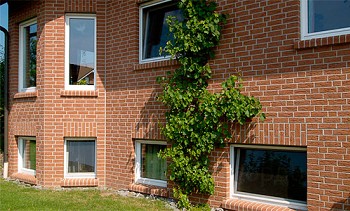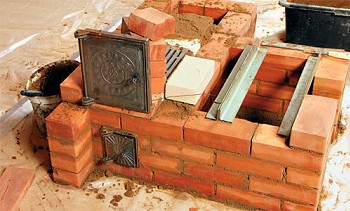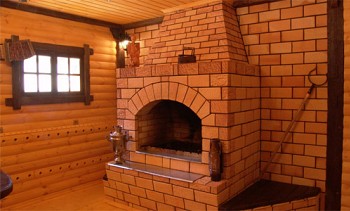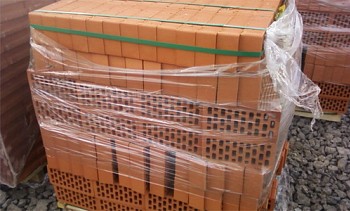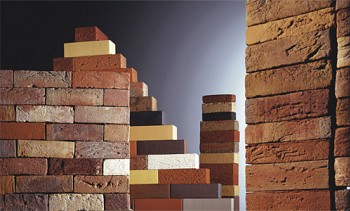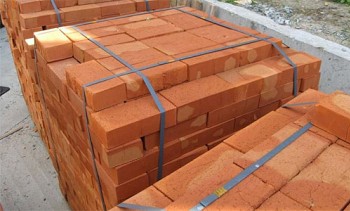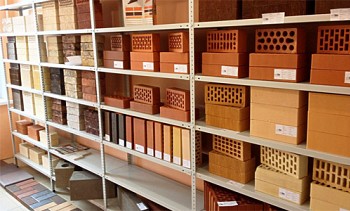Of the widespread building materials (excluding polymers), silicate brick is one of the youngest. Its technology was developed at the end of the 19th century, but mass production and use began in the middle of the last century. We will tell in more detail what silicate brick is, the pros and cons of this building material.
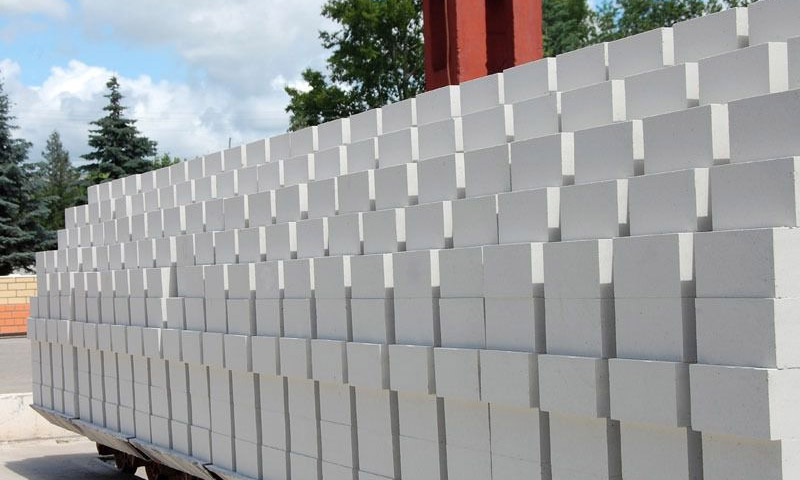
Content:
What is silicate brick and what are its production features
Before we examine in detail the advantages and disadvantages of silicate brick, it is necessary to understand what kind of material is in the technological plan. Silicate brick is almost similar to the natural material limestone, which has been used for more than one thousand years. But, as you know, almost always natural stone (including due to delivery costs) is much more expensive than artificial ones.
Lime-sand mortar, from which the production of silicate brick is carried out, before the invention of Portland cement was the most common masonry material, but it has a huge minus - it is not moisture resistant. Then, after a few years, it becomes resistant to water, but these periods are much longer than the standard concrete now.
Experiments with a long-known mixture of lime and sand began almost simultaneously by the Russian civil engineer Prokhov and Swede Ridin, they tried to make walls and even whole houses industrially from it, as it was understandably impossible to achieve high quality (the more so, concrete based on Portland cement was already widely used) . A bit further German physician (not a builder !!!) Bernardi moved on, he made pressed bricks, which then hardened in the air. But naturally finished products did not have decent moisture resistance. The doctor’s compatriot (also a doctor, but in the field of chemistry) Michaelis tried to process the mixture of lime and sand with steam under pressure. So there was a silicate brick. October 5, 1880 can be considered the date of his birth. Moreover, his invention was not based on calculations (like almost all scientific breakthroughs of that time, take at least the biography of Thomas Alva Edison who created the light bulb, phonograph, etc.), but the result of the trial and error method.
New material gained popularity. Even in the Russian Empire at the beginning of the last century, nine factories producing silicate were already operating. But the real wide distribution of this material falls on the 50s (this is clearly visible by the date of construction of white brick buildings).

Silicate brick production
The process of making silicate brick is quite simple (unlike the production of other building materials), but requires special equipment. Therefore, silicate is produced only industrially; in small workshops, its production is unprofitable.
We list all the stages of manufacturing products:
1. Preparation of the mixture - the amount of sand and lime is dosed, if necessary, water. The necessary additives are introduced (to adjust the composition). The mixture is thoroughly mixed.
2. Molding - the composition is pressed. Moreover, unlike ceramic products, it often remains in shape until the last stage (it all depends on the production line).
3. Autoclaving - molded products are sent to airtight chambers for processing with "sharp" steam. For clarification, acute steam has a temperature above the boiling point of water (100 degrees Celsius) because its pressure is greater than atmospheric.
4. The brick is unloaded from the molds, passes the output control and sent to the consumer.

It should also be noted that the production of silicate brick is very close to the production of foam and gas silicate blocks. Therefore, factories often produce the entire range, and the same autoclaves are used for heat treatment on the lines.
Brands and types of silicate brick
According to the main characteristics, such as density and frost resistance, silicate brick does not differ from the more usual ceramic brick. The characteristics and properties of silicate brick are regulated by GOST 379-79 “Brick and silicate stones. Technical conditions. "
It has the following main characteristics:
- strength grade - M125, M150;
- frost resistance brand - F15, F25, F35;
- thermal conductivity - 0.38-0.70 W / m ° C.
Frost resistance - this is the ability of a material in a water-saturated state to alternately freeze and thaw without changing its characteristics. Frost resistance is measured in cycles and is designated as: "Mrz". or "F".
Strength - the ability of the material to resist internal resistance and deformation. Strength is indicated by the letter "M" and a specific number. The digital value indicates what load per 1 cm2 Can withstand this brick.
Solid and Hollow Brick. But here there is already a difference with ceramic brick, which consists in the fact that the voids in the silicate are usually cylindrical in shape and are located in the center of the massif, the number of ceramics in ceramic is larger, they can be of the most diverse shapes and more evenly distributed throughout the product. Many companies also offer the manufacture of bricks for the size of the customer (medium or large batches), this is due to the fact that it is often formed not by extrusion presses (which are difficult to readjust), but in individual forms.

Pluses of silicate brick
+ Low cost

It is due to the fact that such cheap raw materials as lime and sand are used (though exceptionally high-quality). Also, for the production of such bricks, you can use sharp steam from the CHPP anyway cooled in cooling towers. With the production of ordinary bricks, the raw materials are more expensive and require preliminary exposure (like cognac, clay must lie at least 3 winters in dumps), preliminary grinding and drying of the workpieces. Energy costs for the production of silicate is an order of magnitude less. Almost always, silica masonry is cheaper than even using lightweight concrete with the same bearing capacity.
+ Good environmental friendliness

Such a brick is more environmentally friendly, it does not contain harmful components. In terms of the level of radioactive radiation, it generally differs in the minimum background value compared to not only natural but also to artificial building materials.
+ High compatibility with masonry mortars

Excellent compatibility with any masonry mortar from traditional cement-lime to polymer-based adhesives.
+ Good aesthetic properties

Silicate brick has high aesthetic properties. The natural white color is easily changed by the introduction of pigments that color the material throughout the volume, and not just in the surface layers.
+ Excellent geometry

Each brick has the same geometry, which facilitates the installation of its work.
+ High strength

The strength of silicate brick is from 75 to 200 kg / cm2.
+ Good sound insulation

Due to the fact that the material has a high specific strength, it has good soundproofing properties.
+ High frost resistance

Frost resistance of silicate brick can reach up to 50 freezing-freezing cycles, which undoubtedly, for the better, affects the durability of the material.
But, nevertheless, the main advantage of silicate brick is its low cost, with excellent operational properties, which is why it is so widespread.
Cons of silicate brick
Of course, there is no ideal building material, so we list the disadvantages of silicate brick:
– Heavy material

It is heavier for ceramics and even for natural limestone (30-15%). A foundation with a higher bearing capacity is required. Although in some cases, massive walls are a plus.
– Rapidly destroyed by constant exposure to water

Although it is not inferior to ceramics in frost resistance, with constant exposure to water, the silicate begins to break down. Therefore, it is not used for socles. In addition, often during heavy rains, silicate brick walls are impregnated with water, so that humidity also increases indoors.
– High thermal conductivity

Silicate (not even full-bodied) has better thermal conductivity. Therefore, you need either an increase in the thickness of the walls, or additional insulation.
– Does not withstand high temperatures

Also, unlike ceramics, silicate does not withstand high temperatures. Therefore, for chimneys, and even more so fireboxes, it can not be used either. It can unpredictably collapse due to sudden heating and cooling, or constant exposure to flames or flue gases.
– Lack of flowing shapes and decorative elements

On sale there are only rectangular bricks with right angles.
– High water absorption

Water absorption of silicate brick can reach up to 7 - 8%. That does not allow the use of this material for the construction of various elements where increased humidity can be observed.
Note: From my own experience I often see that in rural areas silicate brick often serves as an alternative to refractory. Fire control naturally cannot determine this. But it is worth cautioning against the use of such materials for furnaces. They can last quite a few years.
BUT, according to observations:
- Any such furnace is necessarily cracked (through which smoke breaks out, and in the worst case, a flame). This is due to the fact that it is impossible to ensure reliable laying of silicate on clay. Their coefficient of thermal expansion is almost an order of magnitude different.
- With prolonged heating, silicate brick can collapse almost instantly. Flames escaping will serve as a source of fire.

